lesson 08 Restaurant Management 旅游管理专业英语PPT课件
- 格式:ppt
- 大小:223.00 KB
- 文档页数:47
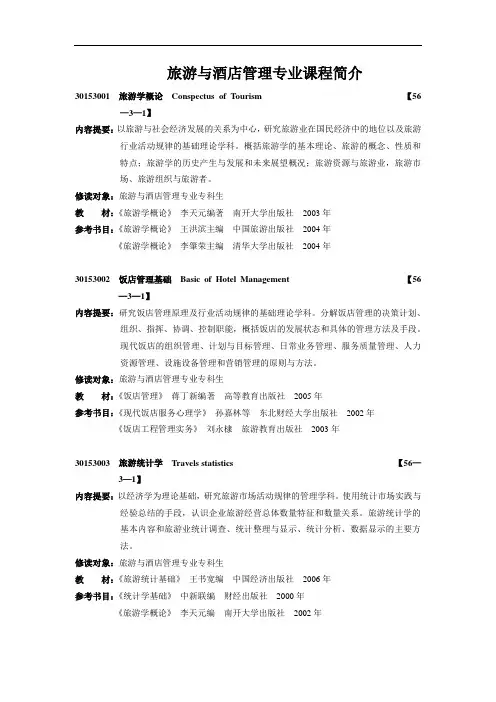
旅游与酒店管理专业课程简介30153001旅游学概论Conspectus of T ourism 【56—3—1】内容提要:以旅游与社会经济发展的关系为中心,研究旅游业在国民经济中的地位以及旅游行业活动规律的基础理论学科。
概括旅游学的基本理论、旅游的概念、性质和特点;旅游学的历史产生与发展和未来展望概况;旅游资源与旅游业,旅游市场、旅游组织与旅游者。
修读对象:旅游与酒店管理专业专科生教材:《旅游学概论》李天元编著南开大学出版社2003年参考书目:《旅游学概论》王洪滨主编中国旅游出版社2004年《旅游学概论》李肇荣主编清华大学出版社2004年30153002饭店管理基础Basic of Hotel Management 【56—3—1】内容提要:研究饭店管理原理及行业活动规律的基础理论学科。
分解饭店管理的决策计划、组织、指挥、协调、控制职能,概括饭店的发展状态和具体的管理方法及手段。
现代饭店的组织管理、计划与目标管理、日常业务管理、服务质量管理、人力资源管理、设施设备管理和营销管理的原则与方法。
修读对象:旅游与酒店管理专业专科生教材:《饭店管理》蒋丁新编著高等教育出版社2005年参考书目:《现代饭店服务心理学》孙嘉林等东北财经大学出版社2002年《饭店工程管理实务》刘永棣旅游教育出版社2003年30153003 旅游统计学T ravels statistics 【56—3—1】内容提要:以经济学为理论基础,研究旅游市场活动规律的管理学科。
使用统计市场实践与经验总结的手段,认识企业旅游经营总体数量特征和数量关系。
旅游统计学的基本内容和旅游业统计调查、统计整理与显示、统计分析、数据显示的主要方法。
修读对象:旅游与酒店管理专业专科生教材:《旅游统计基础》王书宽编中国经济出版社2006年参考书目:《统计学基础》中新联编财经出版社2000年《旅游学概论》李天元编南开大学出版社2002年30153004旅游会计T ravels accountant 【56—3—1】内容提要:研究旅游行业财务活动规律的基础理论学科。

饭店餐饮管理课程英文名Hotel Food and Beverage Management课程编号:学分:2 学时:36先修课程:饭店管理概论替代课程:无一、课程目的要求:饭店餐饮管理是旅游管理专业本科旅游企业管理方向的一门专业课程。
通过本课程的学习,目的是使学生掌握餐饮业务知识,提高餐饮管理的理论水平和管理才能,同时通过专业实践的学习和考核,提高学生的餐饮技能,为促进餐饮业的发展打下良好的基础。
要求学生既要重视管理理论知识的学习,又要积极参与餐饮服务与管理实践,全面提高餐饮管理理论水平和实际工作能力。
二、课程简介:该课程运用现代科学管理原理,结合餐饮管理的实际,系统地阐述了饭店餐饮管理的理论、方法和业务特点,具有丰富的理论性和较强的实践性。
重点讲授了餐饮服务、管理、经营和菜肴酒水知识,以及餐饮的设施、活动、管理和组织等内容,同时通过实践操作的讲授和在餐饮实验室的实践培训、实践考核教会学会基本的服务技能操作,为学生将来从事餐饮管理做好知识和技能储备。
The course using the principl es of modern scientific management and combining with reality of F&B Management, it clarifies the theories, methods and business features in system. Besides, it’s theoretical and practical. The course points at the knowledge of services, management, operation, food and beverage in the part of hotel F&B, while focusing on the facilities, activities, management and organizing in the F&B part. At the same time, it guides students capable of basic service skills through teaching operating skills, training and testing in F&B labs. It’s a good preparation for students to store the knowledge and skills on hotel F&B management in the future.。

Fast-food restaurantA fast-food restaurant is a restaurant characterized by food which is supplied quickly after ordering and by minimal service. Food purchased may or may not be eaten quickly as well. Often this food is referred to fast food. In response to increasing backlash against "fast-food", the industry has been trying to move the public away from the term "fast food" over the past five years, shifting to the term quick service restaurant (QSR for short). QSR has not, however, been seen used in regular speech.The food in these restaurants is commonly cooked in bulk in advance and kept hot, or reheated to order. Many fast-food restaurants are part of restaurant chains or franchise operations, which ship standardized foodstuffs to the individual restaurants from central locations. There are also simpler fast-food outlets, such as stands or kiosks, which might or might not provide shelter or chairs for customers (for the UK, see also below).Because the capital requirements to start a fast-food restaurant are relatively low, particularly in areas with non-existent or little enforced health codes, small individually owned fast-food restaurants are common throughout the world.OverviewWithin the United States, fast-food restaurants have been losing market share to so-called fast casual restaurants, which offer somewhat better and more expensive foods. In 2002, the McDonald's Corporation posted its first quarterly loss.Because of this reliance on monoculture, on foodstuffs purchased on global commodity markets and on its displacement of local eating habits, the fast-food industry is seen by many as destroying local styles of cuisine. It is often a focus of resistance (e.g., José Bové's bulldozing a McDonald's which made him a folk hero in France, or the "McShit" campaign in the UK).For these reasons and more, the Slow Food movement seeks to preserve local cuisines and ingredients, and directly opposes laws and habits that favor fast-food choices. Among other things, it strives to educate consumers' palates to prefer the richer and more varied local tastes of fresh ingredients harvested in season.Although fast-food restaurants are often seen as a mark of modern technological culture, they are probably as old as cities themselves, with the style varying from culture to culture. Ancient Roman cities had bread-and-olive stands, East Asian cultures feature noodle shops, flat bread, and falafel are characteristic of the Middle East.In the United Kingdom, while fast-food restaurant chains are now common, the British tradition of take-away foods such as fish and chips and steak and kidney pie with mash (mashed potatoes) remain popular. Closer to the end of the 20th century, these have been joined by take-away outlets selling ethnic or pseudo-ethnic foods such as Italian, Chinese, and Indian. For more on foods in the UK, see British cuisine.United States•A&W•Arby's•Arthur Treacher's•Backyard Burger•Baja Fresh•Baskin-Robbins•Blimpie•Bun Boy•Burger King•Burgerville, USA (Oregon and Southwest Washington Only) •Carl's Jr.•Checkers Drive-In (also called Rally's Drive-In)•Chick-fil-A•Church's Chicken•Cinnabon•Culver's•Dairy Queen (Brazier)•Del Taco•Domino's Pizza•Dunkin' Donuts•El Pollo Loco•Fazoli's•Fatburger•Foster's Freeze•Hamburger Stand with Der Wienerschnitzel•Hardee's•Home Run Inn Pizza (Chicago)•Hot Dog on a Stick•In-N-Out (Arizona, California and Nevada)•Jack in the Box•Johnny Rockets•KFC•Krispy Kreme Donuts•Krystal•Little Caesar's•Long John Silver's•McDonald's•Moe's Southwest Grill•Nathan's Famous•Panda Express•Pioneer Chicken•Pizza Hut•Popeye's Fried Chicken•Quizno's•Raising Cane's Chicken Fingers•Roy Rogers Family Restaurants•Rubio's (mainly California)•Runza Restaurants•Sbarro•Schlotzsky's•Shakey's Pizza•Sonic Drive-In•Steak 'n Shake•Submarina•Subway•Taco Bell•TacoCabana•Taco Johns•Taco Mayo•Taco Tico•Tastee Freeze•The Hat (So. California)•Tim Hortons (New York, Michigan, Maine, Ohio, Kentucky, West Virginia) •Togo's Eateries•Tommy's (Southern California only)•Una Mas!•Wendy's•Whataburger•White Castle•Wienerschnitzel•Winchell's Donuts。
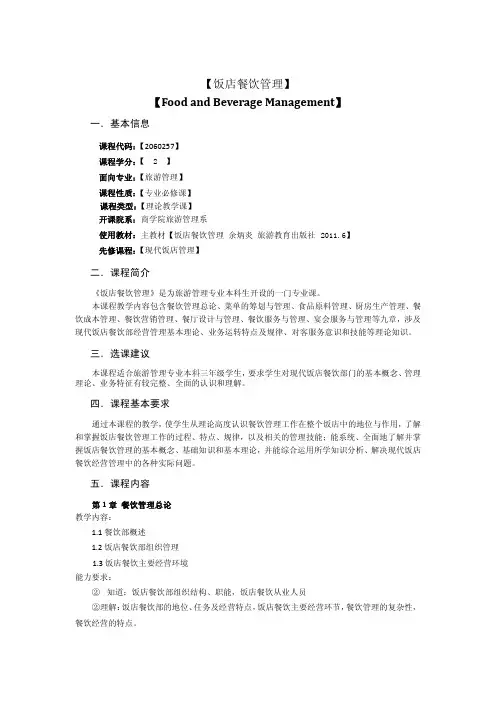
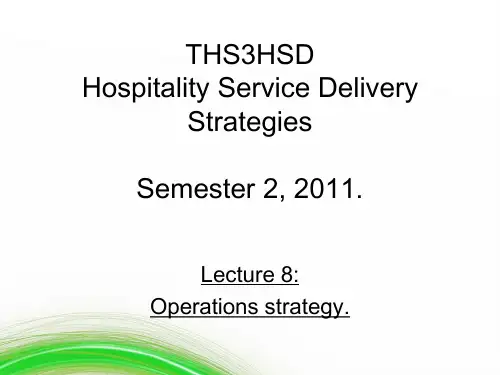
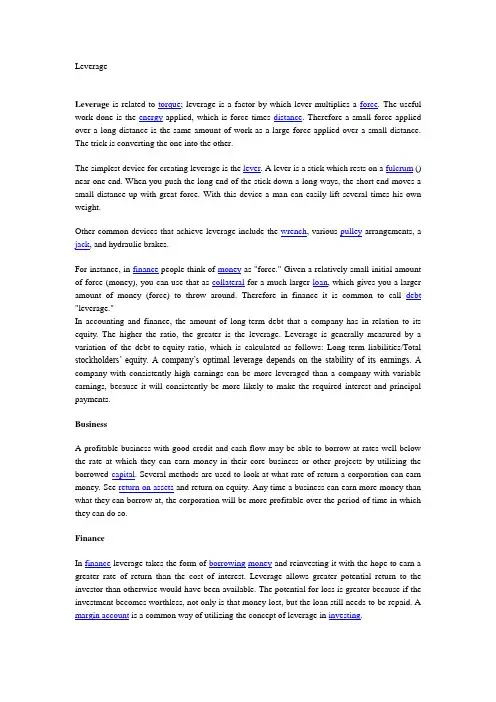
Leverage is related to torque; leverage is a factor by which lever multiplies a force. The useful work done is the energy applied, which is force times distance. Therefore a small force applied over a long distance is the same amount of work as a large force applied over a small distance. The trick is converting the one into the other.The simplest device for creating leverage is the lever. A lever is a stick which rests on a fulcrum () near one end. When you push the long end of the stick down a long ways, the short end moves a small distance up with great force. With this device a man can easily lift several times his own weight.Other common devices that achieve leverage include the wrench, various pulley arrangements, a jack, and hydraulic brakes.For instance, in finance people think of money as "force." Given a relatively small initial amount of force (money), you can use that as collateral for a much larger loan, which gives you a larger amount of money (force) to throw around. Therefore in finance it is common to call debt "leverage."In accounting and finance, the amount of long-term debt that a company has in relation to its equity. The higher the ratio, the greater is the leverage. Leverage is generally measured by a variation of the debt-to-equity ratio, which is calculated as follows: Long-term liabilities/Total stockholders’ equity. A company’s optimal leverage depends on the stability of its earnings. A company with consistently high earnings can be more leveraged than a company with variable earnings, because it will consistently be more likely to make the required interest and principal payments.BusinessA profitable business with good credit and cash flow may be able to borrow at rates well below the rate at which they can earn money in their core business or other projects by utilizing the borrowed capital. Several methods are used to look at what rate of return a corporation can earn money. See return on assets and return on equity. Any time a business can earn more money than what they can borrow at, the corporation will be more profitable over the period of time in which they can do so.FinanceIn finance leverage takes the form of borrowing money and reinvesting it with the hope to earn a greater rate of return than the cost of interest. Leverage allows greater potential return to the investor than otherwise would have been available. The potential for loss is greater because if the investment becomes worthless, not only is that money lost, but the loan still needs to be repaid. A margin account is a common way of utilizing the concept of leverage in investing.Another form of creating leverage using financial instruments is through the use of options. The purchase of a call option on a security gives the buyer the right to purchase the underlying security at a given price in the future. If the price of the underlying security rises, the value of the call option will rise at a rate much greater than the value of the underlying security. However if the rate of the call option falls or does not rise, the call option may be worthless, involving a much greater loss than if the same money had been invested in the underlying instrument.Leverage and riskUtilizing leverage amplifies the potential gain from an investment or project, but also increases the potential loss. This increased risk may be perfectly acceptable or even necessary to reach the goals of the entity or person making the investment. In fact, precisely managing risk utilizing strategies including leverage and securities purchases, is the subject of a discipline known as financial engineering"Slippage"In a rising market, the compounding associated with a leveraged portfolio leads to greater gains; in a declining market, the compounding of a leveraged portfolio may lead to larger losses. However, in a flat market with volatility, the compounding of a leveraged portfolio will cause the portfolio to under perform an identical unleveraged portfolio. Because the percentage increase in a leveraged portfolio is higher by the same ratio as the decrease is higher.ExampleA 100 index going to 110 is a 10% increase. A 110 index going to 100 is a % decrease. In a 200% leveraged index it's a 20% increase, to 120, and a 18.17% (9.09*2) decrease to 98.2.If a target index gains 10% on one day before returning to the original level the next day, a 2.0 beta portfolio will lose 1.8% of its value, and a 1.25 beta portfolio will lose 0.3% of its value.Real worldDuring the 1970s the stock market were "flat". On 31-Dec-79 the Dow Jones Industrial Average closed at 838.74, on 19-Nov-69 it closed at 839.96 ([1] (/q/hp?s=%5EDJI&a=00&b=15&c=1969&d= 00&e=15&f=1980&g=d)). An unleveraged portfolio of DJIA would have ended with the same price as it began the decade (and would have lost value through inflation). A 200% leveraged portfolio holding the DJIA during that period would have lost all of its value.。
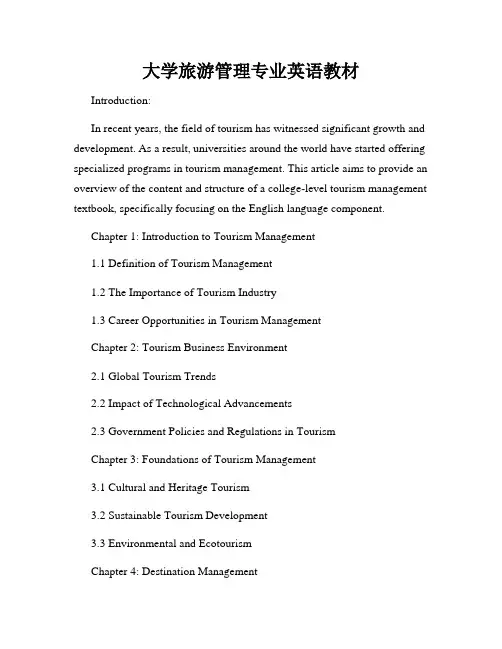
大学旅游管理专业英语教材Introduction:In recent years, the field of tourism has witnessed significant growth and development. As a result, universities around the world have started offering specialized programs in tourism management. This article aims to provide an overview of the content and structure of a college-level tourism management textbook, specifically focusing on the English language component.Chapter 1: Introduction to Tourism Management1.1 Definition of Tourism Management1.2 The Importance of Tourism Industry1.3 Career Opportunities in Tourism ManagementChapter 2: Tourism Business Environment2.1 Global Tourism Trends2.2 Impact of Technological Advancements2.3 Government Policies and Regulations in TourismChapter 3: Foundations of Tourism Management3.1 Cultural and Heritage Tourism3.2 Sustainable Tourism Development3.3 Environmental and EcotourismChapter 4: Destination Management4.1 Destination Marketing and Branding4.2 Tourism Infrastructure Development4.3 Tourism Transportation and Logistics Chapter 5: Hospitality Management5.1 Hotel Operations and Management5.2 Restaurant and Food Service Management 5.3 Customer Service in Hospitality Industry Chapter 6: Event Management6.1 Types of Events in Tourism6.2 Event Planning and Organizing6.3 Event Marketing and PromotionChapter 7: Marketing and Sales in Tourism7.1 Tourism Market Segmentation7.2 Marketing Strategies for Tourism Products 7.3 Sales Techniques in Tourism Industry Chapter 8: Financial Management in Tourism 8.1 Budgeting and Financial Planning8.2 Cost Control and Revenue Management8.3 Financial Analysis and Reporting in TourismChapter 9: Human Resource Management in Tourism9.1 Recruitment and Selection in Tourism Industry9.2 Training and Development of Tourism Professionals9.3 Employee Relations and Performance ManagementChapter 10: Entrepreneurship in Tourism10.1 Identifying Business Opportunities in Tourism10.2 Business Planning and Start-up in Tourism10.3 Managing and Growing a Tourism EnterpriseConclusion:This imaginary textbook aimed at the field of tourism management covers a wide range of topics related to the industry. It provides students with the necessary knowledge and skills to succeed in this dynamic field. By comprehensively covering areas such as tourism business environment, destination management, hospitality management, event management, marketing and sales, financial management, human resource management, and entrepreneurship, the textbook equips students with a solid foundation in the field of tourism management.Please note that this is an example response and the actual content and structure of a college-level tourism management textbook may vary.。
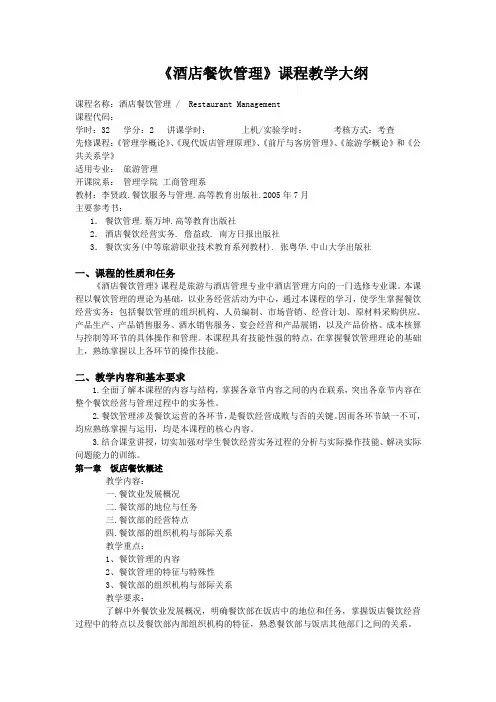
《酒店餐饮管理》课程教学大纲课程名称:酒店餐饮管理 / Restaurant Management课程代码:学时:32 学分:2 讲课学时:上机/实验学时:考核方式:考查先修课程:《管理学概论》、《现代饭店管理原理》、《前厅与客房管理》、《旅游学概论》和《公共关系学》适用专业:旅游管理开课院系:管理学院工商管理系教材:李贤政.餐饮服务与管理.高等教育出版社.2005年7月主要参考书:1.餐饮管理.蔡万坤.高等教育出版社2.酒店餐饮经营实务. 詹益政. 南方日报出版社3.餐饮实务(中等旅游职业技术教育系列教材). 张粤华.中山大学出版社一、课程的性质和任务《酒店餐饮管理》课程是旅游与酒店管理专业中酒店管理方向的一门选修专业课。
本课程以餐饮管理的理论为基础,以业务经营活动为中心,通过本课程的学习,使学生掌握餐饮经营实务:包括餐饮管理的组织机构、人员编制、市场营销、经营计划、原材料采购供应、产品生产、产品销售服务、酒水销售服务、宴会经营和产品展销,以及产品价格、成本核算与控制等环节的具体操作和管理。
本课程具有技能性强的特点,在掌握餐饮管理理论的基础上,熟练掌握以上各环节的操作技能。
二、教学内容和基本要求1.全面了解本课程的内容与结构,掌握各章节内容之间的内在联系,突出各章节内容在整个餐饮经营与管理过程中的实务性。
2.餐饮管理涉及餐饮运营的各环节,是餐饮经营成败与否的关键。
因而各环节缺一不可,均应熟练掌握与运用,均是本课程的核心内容。
3.结合课堂讲授,切实加强对学生餐饮经营实务过程的分析与实际操作技能、解决实际问题能力的训练。
第一章饭店餐饮概述教学内容:一.餐饮业发展概况二.餐饮部的地位与任务三.餐饮部的经营特点四.餐饮部的组织机构与部际关系教学重点:1、餐饮管理的内容2、餐饮管理的特征与特殊性3、餐饮部的组织机构与部际关系教学要求:了解中外餐饮业发展概况,明确餐饮部在饭店中的地位和任务,掌握饭店餐饮经营过程中的特点以及餐饮部内部组织机构的特征,熟悉餐饮部与饭店其他部门之间的关系。
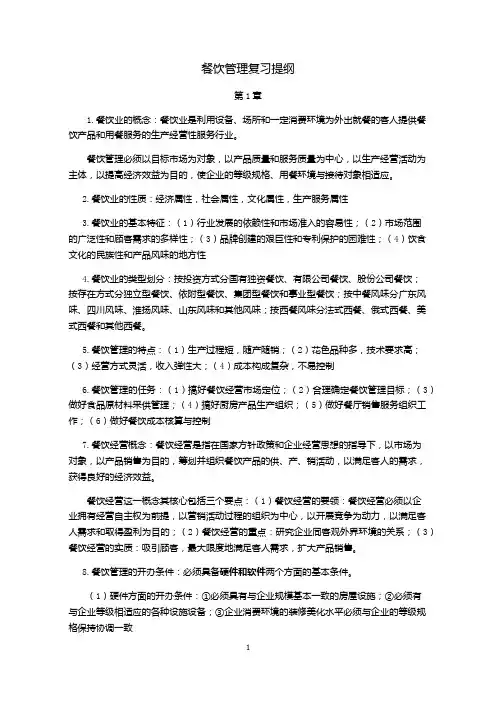
餐饮管理复习提纲第1章1.餐饮业的概念:餐饮业是利用设备、场所和一定消费环境为外出就餐的客人提供餐饮产品和用餐服务的生产经营性服务行业。
餐饮管理必须以目标市场为对象,以产品质量和服务质量为中心,以生产经营活动为主体,以提高经济效益为目的,使企业的等级规格、用餐环境与接待对象相适应。
2.餐饮业的性质:经济属性,社会属性,文化属性,生产服务属性3.餐饮业的基本特征:(1)行业发展的依赖性和市场准入的容易性;(2)市场范围的广泛性和顾客需求的多样性;(3)品牌创建的艰巨性和专利保护的困难性;(4)饮食文化的民族性和产品风味的地方性4.餐饮业的类型划分:按投资方式分国有独资餐饮、有限公司餐饮、股份公司餐饮;按存在方式分独立型餐饮、依附型餐饮、集团型餐饮和事业型餐饮;按中餐风味分广东风味、四川风味、淮扬风味、山东风味和其他风味;按西餐风味分法式西餐、俄式西餐、美式西餐和其他西餐。
5.餐饮管理的特点:(1)生产过程短,随产随销;(2)花色品种多,技术要求高;(3)经营方式灵活,收入弹性大;(4)成本构成复杂,不易控制6.餐饮管理的任务:(1)搞好餐饮经营市场定位;(2)合理确定餐饮管理目标;(3)做好食品原材料采供管理;(4)搞好厨房产品生产组织;(5)做好餐厅销售服务组织工作;(6)做好餐饮成本核算与控制7.餐饮经营概念:餐饮经营是指在国家方针政策和企业经营思想的指导下,以市场为对象,以产品销售为目的,筹划并组织餐饮产品的供、产、销活动,以满足客人的需求,获得良好的经济效益。
餐饮经营这一概念其核心包括三个要点:(1)餐饮经营的要领:餐饮经营必须以企业拥有经营自主权为前提,以营销活动过程的组织为中心,以开展竞争为动力,以满足客人需求和取得盈利为目的;(2)餐饮经营的重点:研究企业同客观外界环境的关系;(3)餐饮经营的实质:吸引顾客,最大限度地满足客人需求,扩大产品销售。
8.餐饮管理的开办条件:必须具备硬件和软件两个方面的基本条件。
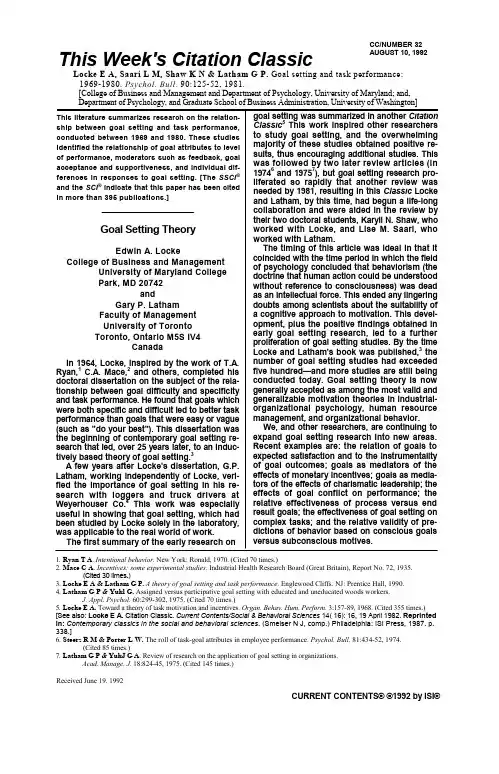
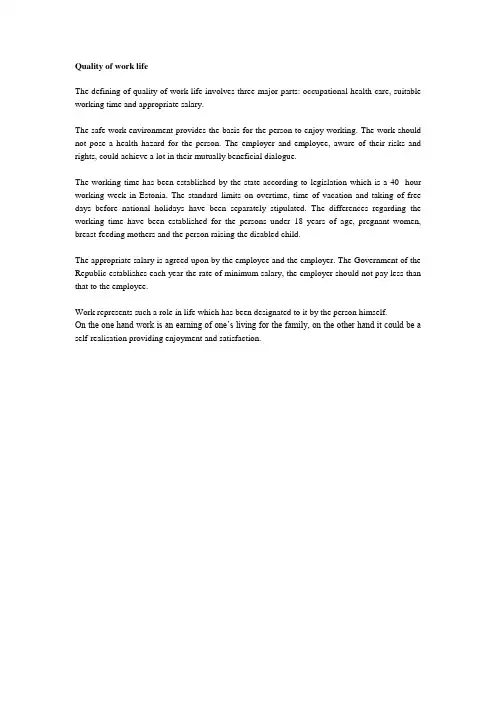
Quality of work lifeThe defining of quality of work life involves three major parts: occupational health care, suitable working time and appropriate salary.The safe work environment provides the basis for the person to enjoy working. The work should not pose a health hazard for the person. The employer and employee, aware of their risks and rights, could achieve a lot in their mutually beneficial dialogue.The working time has been established by the state according to legislation which is a 40- hour working week in Estonia. The standard limits on overtime, time of vacation and taking of free days before national holidays have been separately stipulated. The differences regarding the working time have been established for the persons under 18 years of age, pregnant women, breast-feeding mothers and the person raising the disabled child.The appropriate salary is agreed upon by the employee and the employer. The Government of the Republic establishes each year the rate of minimum salary, the employer should not pay less than that to the employee.Work represents such a role in life which has been designated to it by the person himself.On the one hand work is an earning of one’s living for the family, on the other hand it could be a self-realisation providing enjoyment and satisfaction.。
餐旅管理系Department of Hotel and Restaurant Managemen t一、必修科目Required Courses632001 餐旅管理概論3必鍾辰英、上本課程旨在介紹學生有關餐旅產業的基本認識。
課程內容包括餐旅產業的精神與範疇、觀光業與旅行、旅館產業、餐飲產業、會議產業、溫泉產業概要、以及餐旅業倫理、餐旅生涯規畫。
632001 Introduction to Hospitality 3R C. Y. Chung, S ManagementThis course introduces the basic concept in Hospitality Industry. The content includes the following topics: hospitality spirit, tourism and travel, lodging industry, food and beverage industry, convention industry, and ethics in hospitality, professional plans in hospitality.632002 餐旅服務技術及實習3必賴佩均、上本課程主要目的在使學生瞭解餐飲服務的知識及規範,熟練餐旅服務之能,培正的服務態度及職業道德。
主要內容包括旅館櫃檯服務、旅館預約服務、旅館服務中心服務、旅館房務服務、餐飲服務基本概念、基本烹調法原理及其應用、菜單之認識與點菜服務、飲料單之認識與飲料服務、餐廳準備基本技能、收善餐務、結帳、消防與逃生。
632002 Hospitality Service Skill and 3R P. C. Lai, SPracticeThe objective of this course is to introduce the underpinnings of a style of professional service that enhance the hotel and restaurant business. These underpinnings help students to learn how to provide the professional service in hotels restaurants. The course includes the fundamentals of front office services, reservations, uniform services, housekeeping operations, food and beverage service skills, food preparation and application, understanding the menu and ordering, beverage service, wine service, farewells, special service challenges, money handing, safety, and sanitation. 632003 餐飲衛生與安全3必簡孜曲、下本課程旨在協助學生瞭解有關飲食之直接或間接引起危害健康的原因,並設法加以預防、減少或去除該等危害因素,以確保大眾飲食生活的安全。
餐饮业务管理第一章餐饮业概述一、餐饮业概念(一)定义餐饮业:利用餐饮设备、场所和餐饮原料,从事饮食烹饪加工,为社会生活服务的生产经营性服务行业。
餐饮服务:为在家庭以外的场所提供即刻消费的食品及饮品的经营过程。
餐饮服务业是一个由各类餐饮服务企业构成的规模巨大的行业,它为离家外出的人们,甚至是居家的人们提供各种饮食。
餐饮业的三个组成要素:(1)必须要有餐食或饮料提供;(2)有足够令人放松精神的环境或气氛;(3)有固定场所,能满足顾客差异化的需求与期望,并使经营者实现特定的经营目标与利润。
(二)类型1、各类独立经营的餐饮服务机构,包括社会餐厅、餐馆、酒楼、餐饮店(即英语中所称的Restaurant)快餐店、小吃店、茶馆、酒吧和咖啡屋。
2、宾馆、酒店、度假村、公寓等(即英语里所称的Hotel、Motel、Guesthouse)场所内部的餐饮部系统,包括各种风味的中西式餐厅、酒吧、咖啡厅和泳池茶座。
3、企事业单位的餐厅及一些社会保障与服务部门的餐饮服务机构,包括企事业单位食堂、餐厅、学校、幼儿园的餐厅,监狱的餐厅、医院的餐厅、军营的餐饮服务机构。
4、其他(1)休闲与娱乐场所:酒吧、夜总会等。
(2)交通工具上的餐饮设施:飞机、火车、长途汽车等。
(3)大型餐饮配送中心:如夏商集团。
(4)边缘餐饮:茶馆、街头小吃、饮料吧等。
饭店餐饮(1)饭店餐饮业的发展①早期的饭店餐饮业基本模仿港台地区和国外饭店,不但中西餐种类齐全,而且充分顾及散客和宴会、本地特色以及不同档次消费之间的平衡。
一般酒店都有三五个餐厅,且在高端和团体市场上几乎没有竞争对手。
②20世纪90年代的变化饭店业急速扩张,但不再简单模仿,开始考虑本地市场的容量和消费水平。
西餐规模压缩;宴会与零点餐厅界限变得模糊;包厢服务形式流行起来;很多饭店只存在一两个多功能型餐厅。
整体而言,饭店餐饮业经营压力增大,社会餐厅替代竞争明显,“住在宾馆,吃在餐馆”。
③成熟阶段的饭店餐饮业1997年前后,大多数饭店餐饮部门普遍感受到来自顾客和直接竞争对手的压力,产业形势发生变化。